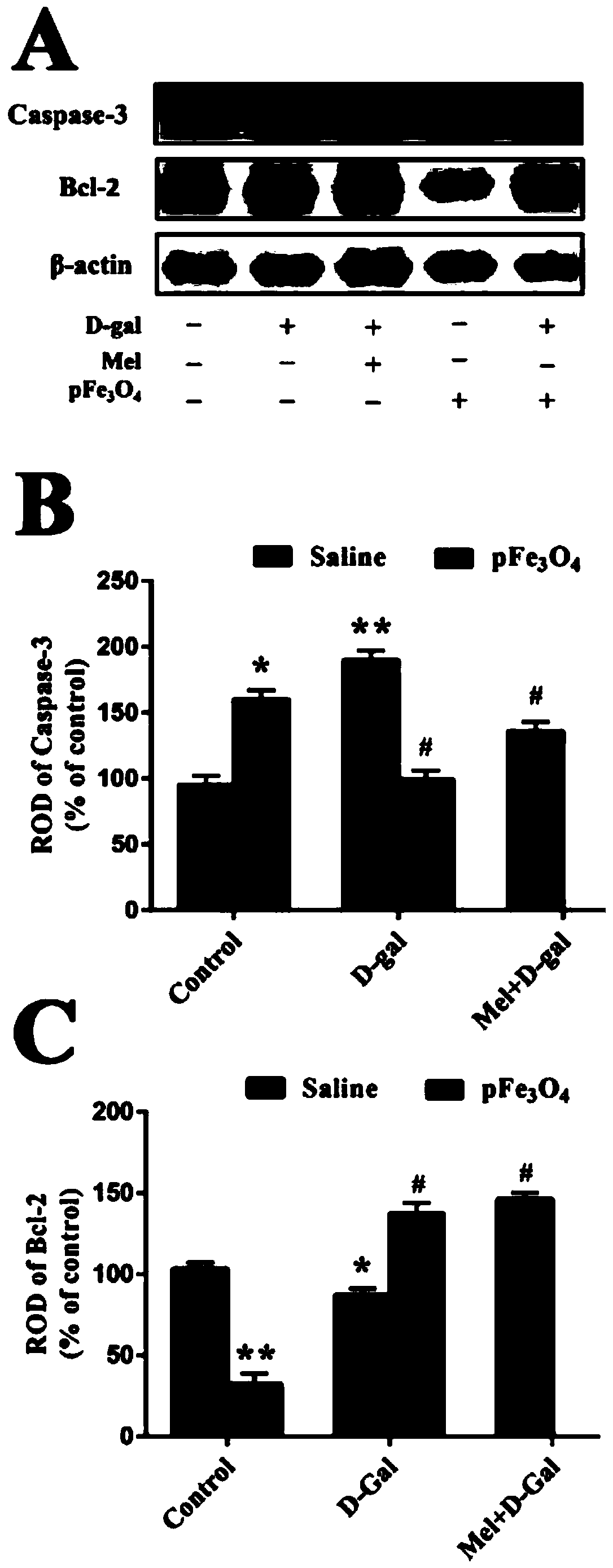New application of ferroferric oxide nano-enzyme
A technology of ferric oxide and nano-enzymes, which can be used in medical preparations of non-active ingredients, nervous system diseases, capsule delivery, etc., and can solve problems such as cognitive and memory impairment, reduction of neural differentiation, and oxidative stress
- Summary
- Abstract
- Description
- Claims
- Application Information
AI Technical Summary
Problems solved by technology
Method used
Image
Examples
Embodiment 1
[0031] Embodiment 1: animal model preparation
[0032] The present invention adopts male 8-week-old male ICR mice recognized by international academic circles, with a body weight of 18-22g and 2-3 months old, purchased from the Comparative Medicine Center of Yangzhou University, and kept at an appropriate temperature (23°C) and humidity (60%). 12-hour light / 12-hour dark environment, after adaptive feeding for 1 week. The mice in the normal control group normally ate and drank, and the animals were randomly divided into 5 groups (14 in each group):
[0033] 1) Control group (0.9% normal saline), 2) 100mg / kg D-galactose treatment group (D-gal-group), 3) 50mg / kg melatonin d-gal group (Mel-gal group), 4 ) 10μg / ml PEG-Fe3O4 nanozyme treatment group (pfe3O4-group); 5) 10μg / ml PEG-Fe3O4 nanozyme+100mg / kg D-gal treatment group (pFe3O4+D-gal group).
[0034] D-galactose was injected intraperitoneally at 100 mg / kg, once a day, for a total of 12 weeks to prepare the mouse model. It ha...
Embodiment 2
[0035] Example 2: Protective effect of PEG-Fe3O4 nanozyme on neurogenesis in DG region of hippocampus of mice treated with D-gal
[0036] This part adopts the animal model described in Example 1, and drinks Fe3O4 nanozyme every day for 4 weeks. After the last administration, the mouse is deeply anesthetized for 1 hour, and the brain tissue is quickly stripped, perfused with 4% paraformaldehyde, dehydrated with gradient sucrose, and the brain tissue Frozen sections were performed, and hippocampal slices were selected according to the brain atlas for immunohistochemical staining, and the morphology of neuroblasts was observed using an electron microscope.
[0037] The result is as figure 1 Shown: Doublecortin (DCX) is a microtubule-associated protein present in migrating neuroblasts, and it is one of the specific markers of early neurons. The number of DCX+ cells is related to the rate of neurogenesis, and DCX-positive cells mainly in the subgranular layer of the dentate gyrus ...
Embodiment 3
[0039] Example 3: Effect of PEG-Fe3O4 nanozyme on platelet endothelial cell adhesion molecule-1 (PECAM-1) in DG region of mouse hippocampus treated with D-gal.
[0040] This part adopts the animal model described in Example 1, and drinks Fe3O4 nanozyme every day for 4 weeks. After the last administration, the mouse is deeply anesthetized for 1 hour, and the brain tissue is quickly stripped, perfused with 4% paraformaldehyde, dehydrated with gradient sucrose, and the brain tissue Frozen sections were performed, and hippocampal brain slices were selected for immunohistochemical staining according to the brain atlas, and the expression of platelet endothelial cell adhesion molecule-1 (PECAM-1) in the vascular endothelium was observed using an electron microscope.
[0041] The result is as figure 2 Shown: the expression of PECAM-1 was easily detected in the hippocampal DG area of the control group ( figure 2 A). In the D-gal group, we noticed a significant decrease in PECAM-...
PUM
| Property | Measurement | Unit |
|---|---|---|
| Diameter | aaaaa | aaaaa |
Abstract
Description
Claims
Application Information
 Login to View More
Login to View More - R&D
- Intellectual Property
- Life Sciences
- Materials
- Tech Scout
- Unparalleled Data Quality
- Higher Quality Content
- 60% Fewer Hallucinations
Browse by: Latest US Patents, China's latest patents, Technical Efficacy Thesaurus, Application Domain, Technology Topic, Popular Technical Reports.
© 2025 PatSnap. All rights reserved.Legal|Privacy policy|Modern Slavery Act Transparency Statement|Sitemap|About US| Contact US: help@patsnap.com



